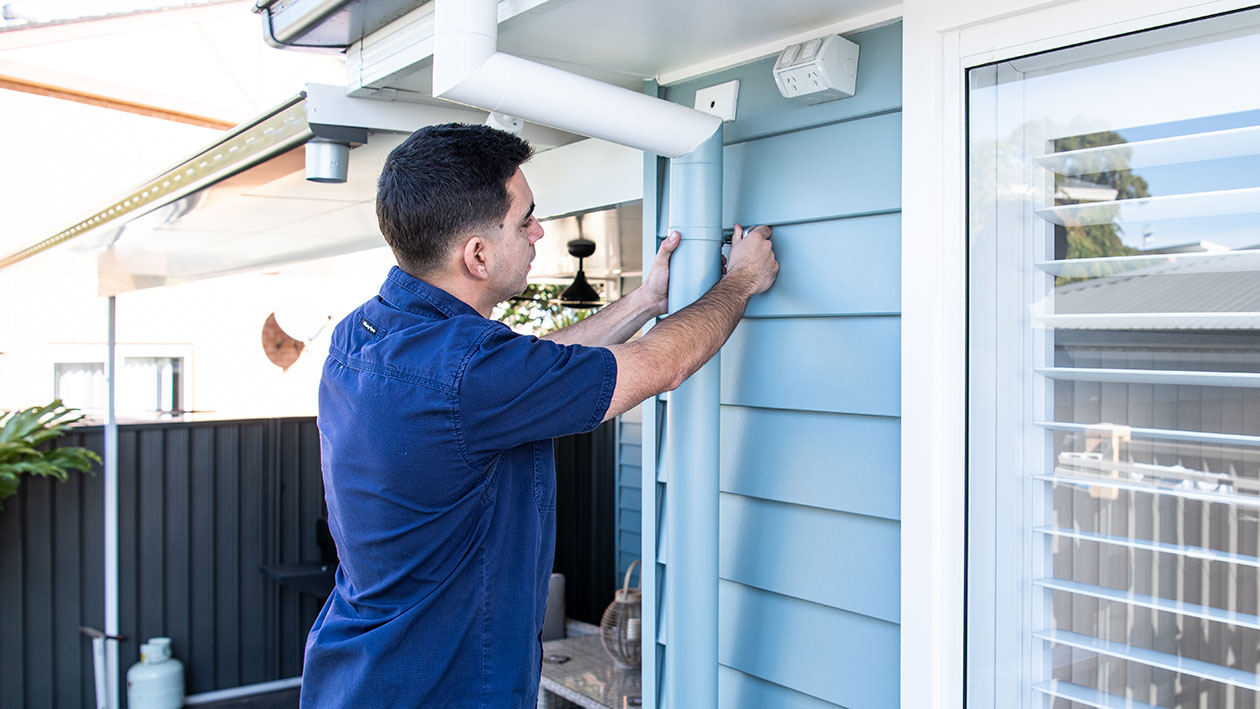Discovering a water leak can be stressful. But don’t panic! This guide provides practical steps and solutions to help you locate and address that leak effectively. We’ll cover common problem areas, simple DIY techniques, and when to call in the experts.
Where is the Water Coming From?
Before you can fix a leak, you need to find it. This can be tricky, as leaks often appear far from their source. Let’s break down how to identify the leak’s location, focusing on common problem areas:
Behind Walls
- Look for: Damp patches, peeling paint, a musty odour, or wall discolouration.
- A moisture meter can confirm if the wall is retaining water.
In Ceilings
- Look for: Water stains, bulging plasterboard, dripping water, or a damp, musty smell.
- Trace the leak’s path: Water often travels along joists or beams, so check those areas too.
Underground
- Look for: Excessive lush patches of grass, sinking ground, or unexplained puddles.
- Check your water meter: If it’s running even when all taps are off, you likely have an underground leak.
In Roofs
- Look for: Missing or damaged shingles/tiles, gaps around vents or chimneys, and water stains in the attic.
- Check after rainfall: Roof leaks are often most apparent during or immediately after a storm.
Outside
- Look for: Soggy areas in your yard, leaking hot water heater, unusually high water bills, or the sound of running water when no outdoor taps are on.
- Check your irrigation system: Faulty sprinklers or leaking pipes are common culprits.
DIY Leak Detection – What’s the Easiest Way To Find a Leak?
Once you’ve narrowed down the potential leak location, this is the easiest DIY method for confirming the water leak:
The Water Meter Test
- Turn off all water sources inside and outside your home.
- Locate your water meter and note the reading.
- Wait 30 minutes without using any water.
- Recheck the meter. If the reading has changed, there is a leak in your plumbing system.
Simple Tools for Leak Detection
- Moisture Meter: This inexpensive device helps you determine the moisture level in walls, floors, and ceilings, confirming water presence even without visible signs.
- Dye Test: Dye Test: Put a few drops of food colouring in the tank for toilet leaks. If colour appears in the bowl without flushing, there’s a leak in the flapper or other tank components. Follow our step-by-step guide on how to test a toilet flush valve to confirm the issue and fix it..
- Listening Devices: Some leaks make noise! You can use a stethoscope or a long screwdriver pressed against pipes or walls to listen to hissing or dripping sounds.
- Visual Inspection: For appliances like a dishwasher and washing machine, visually inspect the hoses and connections for signs of wear, cracks, or dripping water.
When to Call in the Professionals
While some types of water leaks are simple DIY fixes, others require professional expertise. Here’s when to call a licensed plumber:
- You Can’t Find the Leak: If you’ve tried the methods above but can’t pinpoint the source, a plumber has specialised equipment, such as thermal imaging cameras and acoustic leak detectors, to locate hidden leaks quickly and accurately.
- The Leak is Complex: Leaks involving gas lines, sewer lines, or underground pipes are best left to the pros. These situations require specialised knowledge and tools to repair safely and effectively.
- The Damage is Extensive: If the leak has caused significant damage to your home’s structure, flooring, or walls, it’s crucial to call a professional for a thorough assessment and repairs.
How Do Plumbers Detect Hidden Leaks?
There are several methods plumbers use to detect and locate water leaks:
Visual Inspection
The first step is often a visual inspection to look for obvious signs of leaks, such as:
- Water stains on ceilings, walls, or floors
- Mould or mildew growth
- Warped or buckling surfaces
- Puddles of water
Advanced Detection Tools
Plumbers use specialised equipment to pinpoint hidden leaks:
- Thermal Imaging Cameras – these detect subtle temperature differences caused by water, allowing technicians to see moisture behind walls or under floors without invasive measures.
- Acoustic Sensors – these highly sensitive microphones can pick up the sound of water escaping from pipes, even when hidden underground or in walls.
- Ultrasonic Leak Detectors – these devices use sound waves to detect the high-frequency noise produced by pipe pressurised leaks.
- Ground Penetrating Radar (GPR) – GPR can detect changes in soil density or structural irregularities underground that may indicate a leak.
Water Pressure and Flow Tests
- Water Meter Test – checking the water meter when all fixtures are off can reveal if water is still flowing, indicating a leak.
- Water Pressure Testing – analysing drops in water pressure can help locate large leaks in the system.
Other Methods
- Video pipe inspection using fibre optic cameras to inspect the inside of pipes visually.
- Tracer gas detection, where non-toxic gas is pumped into empty pipes, and sensors detect where it escapes.
- Drone imaging for scanning large areas from above.
By combining these various techniques, skilled plumbers can accurately locate even small hidden leaks without causing unnecessary damage to the property.
Common Water Leak Issues and Solutions
Some water leaks are more common than others. Let’s explore a few familiar culprits and how to address them:
- Cause: Usually worn-out washers or O-rings.
- Solution: These are typically easy DIY fixes. You can find replacement parts at most hardware stores and follow online tutorials.
- Cause: A faulty flapper, fill valve, or chain is often the culprit. You may also see leaks from the base of your toilet.
- Solution: Like dripping taps, these parts are readily available and replaceable with a little guidance.
Leaking Pipes Under the Sink
- Cause: Loose connections, corroded pipes, or damaged pipe seals.
- Solution: If tightening connections don’t work, you may need to replace pipe sections. A plumber is often best suited to handle this task, especially if corrosion is present.
Roof Leaks
- Cause: Damaged or missing shingles, cracked flashing, or clogged gutters.
- Solution: While minor repairs like replacing a shingle can be a DIY project, it’s generally safer and more effective to hire a qualified roofer, especially for larger repairs.
Can I Use My Phone To Detect Underground Water?
Yes, you can use your phone to detect underground water, but it’s important to understand the limitations and accuracy of this method. Several mobile apps are available that claim to help detect underground water sources using your phone’s built-in sensors. Some popular options include:
- Water Finder
- Aqua Scan
- Hydro Seeker
These apps typically use your phone’s magnetometer and other sensors to detect electromagnetic frequencies that may indicate the presence of water.
The principle behind using a phone to detect underground water is based on electromagnetic waves. Water sources emit unique electromagnetic frequencies, which can be detected by your phone’s sensors when used with specialised apps.
Steps to Use Your Phone for Water Detection
- Download a water detection app from your phone’s app store.
- Calibrate the app to your specific phone model for accurate readings.
- Select the water detection mode in the app.
- Hold your phone steady and slowly move it across where you suspect underground water.
- Observe the app’s real-time readings for indications of water presence and depth.
Limitations and Considerations
While using your phone to detect underground water can be convenient and cost-effective, it’s important to be aware of its limitations:
- Accuracy: These methods are rarely 100% accurate.
- Depth limitations: Phone sensors often struggle to detect water sources at greater depths.
- Environmental factors: Nearby objects or electromagnetic fields can interfere with readings.
Finding and fixing a water leak doesn’t have to be overwhelming. By following the steps outlined in this guide, you can confidently tackle common leak issues and protect your home from potential water damage. Early detection is key, and knowing when to call in a professional can save you time, money, and stress in the long run.



